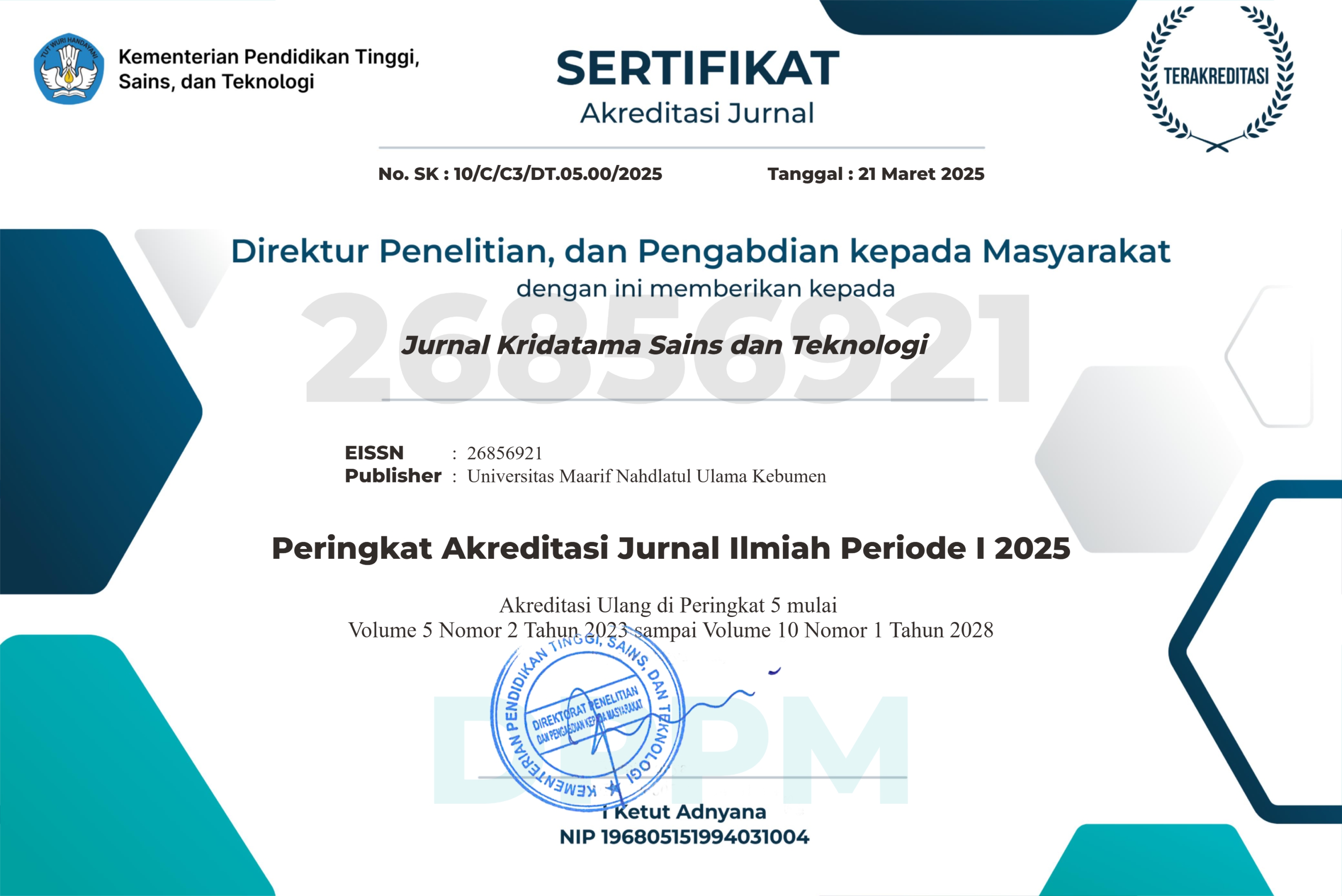Pengembangan Aplikasi Simulasi Berbasis Web terhadap Kompetensi Kognitif Crimping Kabel UTP Siswa SMK
DOI:
https://doi.org/10.53863/kst.v7i02.1867Keywords:
UTP Cable, Cognitive Competence, TKJ, ISO 25010, TAMAbstract
In the field of computer networks and telecommunications, one of the basic skills that must be mastered is the installation of UTP (Unshielded Twisted Pair) cables. This skill is the main foundation in building network systems. However, in practice, the learning process often faces obstacles. Limited practice equipment, the risk of student errors that can cause equipment damage, and short learning times make it difficult for students to understand the concept in depth. This condition causes some students to have difficulty understanding the procedures and logic of UTP cable installation. To address these challenges, this study developed and tested a web-based simulation application called "Crosslink". This application is designed to provide an interactive learning experience without the risk of device damage. This study used the Research and Development (R&D) method with the 4D model (Define, Design, Develop, and Disseminate) which aims to produce valid, practical, and effective learning products. There are two types of validators, namely material experts and media experts. Material experts’ assessments measure content suitability, while media experts’ assessments refer to ISO 25010, and user response testing uses the Technology Acceptance Model (TAM) parameters. This study involved 35 students majoring in Computer Networking (TKJ) at SMK Ketintang Surabaya as respondents. The validation results from material experts were 86.67% and from media experts were 81.67%, indicating that the application meets software quality standards and is suitable for use in learning. Meanwhile, the user response results reached 80.47%, indicating that the application is easy to use in learning the UTP cable crimping process. These findings indicate that Crosslink not only meets the technical feasibility aspect, but also supports learning based on cognitive load theory by helping students focus on understanding crimping concepts without the risk of practical errors.
References
Buana, W., Hariyandi, A., & Rezi, F. (2023). Pengembangan jaringan local area network (LAN) dan wide area network (WAN) pada SMKN 4 Padang dengan metode research dan development. JOISIE: Journal of Information System and Informatics Engineering, 7(1), 120–134. https://ejournal.pelitaindonesia.ac.id/ojs32/index.php/JOISIE/article/view/3268
Cahyadi, F., Zainuddin, M., & Arifin, S. (2025). Pengembangan e-modul etnomatematika batik berbasis PjBL untuk meningkatkan kemampuan berpikir kritis siswa sekolah dasar. Briliant: Jurnal Riset dan Konseptual, 10(1). https://jurnal.unublitar.ac.id/index.php/briliant/article/view/1898
Davis, F. D. (1989). Perceived usefulness, perceived ease of use, and user acceptance of information technology. MIS Quarterly, 13(3), 319–340. https://doi.org/10.2307/249008
Hasim, M., & Hadi, S. (2022). Pengembangan virtual laboratory berbasis virtual reality pada mata pelajaran jaringan LAN di SMK Negeri 1 Rengasdengklok. JAVIT: Journal of Vocational Instruction and Technology, 2(2), 91–100. https://ejournal.undiksha.ac.id/index.php/javit/article/view/48252
Junaedi, A. P., Adriansyah, A. F., Wathoni, M., & Ramadi, R. (2025). Rancang bangun e-learning mata pelajaran Teknologi Informasi dan Komunikasi (TIK) Madrasah Aliyah Annajah Jakarta. Jurnal Penelitian, Pendidikan dan Pengajaran (JPPP), 6(2), 110–119. https://doi.org/10.30596/jppp.v6i2.26275
Kementerian Ketenagakerjaan Republik Indonesia. (2021). Proyeksi kebutuhan tenaga kerja sektor teknologi informasi dan komunikasi 2021–2025. Satudata Kemnaker. https://satudata.kemnaker.go.id/satudata-public/2022/04/files/publikasi/1650296308464_2021%2520-%2520Buku%2520Proyeksi%2520Kebutuhan%2520Tenaga%2520Kerja%2520Sektor%2520TI.pdf
Kementerian Pendidikan, Kebudayaan, Riset, dan Teknologi. (2025). CP & ATP Fase E: Dasar-dasar Teknik Jaringan Komputer dan Telekomunikasi. https://guru.kemdikbud.go.id/kurikulum/referensi-penerapan/capaian-pembelajaran/smk/dasar-dasar-teknik-jaringan-komputer-dan-telekomunikasi/fase-e/
Mursid, R., & Nanlohy, D. A. (2024). Pengembangan aplikasi simulasi berbasis Android untuk meningkatkan hasil belajar peserta didik pada pembelajaran sains di SMA. Jurnal Pendidikan Teknologi dan Kejuruan, 10(1), 45–58. https://jptk.undana.ac.id/index.php/jptk/article/view/4055
Septanto, W. H., Handayani, S., & Rachman, F. (2024). Pelatihan crimping kabel UTP tipe straight dan cross over jaringan komputer LAN untuk para pemuda Kelurahan Pulo Gebang, Kecamatan Cakung, Jakarta Timur. Jurnal Karya untuk Masyarakat (JKuM), 5(1), 33–40. https://ejournal.starki.id/index.php/jkum/article/view/2900
Setyanto, B. N., Mushlihudin, & Pradana, D. Y. (2021). Quality analysis of a learning media analog electronics on the Android platform with ISO 25010. JOVES: Journal of Vocational Education Studies, 4(1), 112–119. https://doi.org/10.12928/joves.v4i1.4047
Sugiyono. (2016). Metode penelitian kuantitatif, kualitatif, dan R&D. Alfabeta.
Sugiyono. (2013). Metode penelitian kuantitatif, kualitatif dan R&D. Alfabeta.
Sweller, J. (1998). Cognitive load during problem solving: Effects on learning. Cognitive Science, 12(2), 257–285. https://doi.org/10.1207/s15516709cog1202_4
Toresa, D., Putra, P. P., Febriadi, B., & Handayani, S. (2023). Pelatihan dasar jaringan komputer untuk siswa Teknik Komputer dan Jaringan (TKJ) SMK Migas Inovasi Riau. J-COSCiS: Journal of Computer Science Community Service, 3(1), 27–32. https://doi.org/10.31849/jcoscis.v3i1.10891
Downloads
Published
How to Cite
Issue
Section
License
Copyright (c) 2025 Ramadhan Cakra Wibawa, Ahmad Zulkifli Baihaqi, Yudha Bima Herlambang, Cahya Dwi Rahmawati, Muhammad Angga Pratama

This work is licensed under a Creative Commons Attribution-ShareAlike 4.0 International License.
Authors retain copyright and grant the journal right of first publication with the work simultaneously licensed under a Creative Commons Attribution-ShareAlike 4.0 International License that allows others to share the work with an acknowledgment of the work’s authorship and initial publication in this journal

















